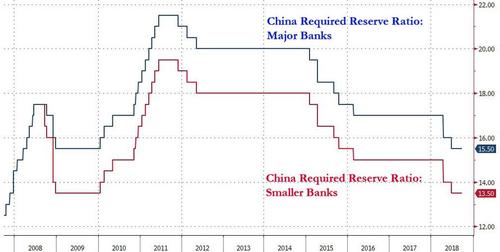China’s central bank announced it would cut the Required Reserve Ratio (RRR) for most banks by 1.0% effective October 15 for the fourth time in 2018, a little over three months after the PBOC announced a similar cut on June 24, as Beijing seeks to stimulate the slowing economy amid the growing trade war with the US, a slumping stock market, a sliding yuan and a record number of bond defaults.

The People’s Bank of China announced on Sunday local time that it lowered the required reserve ratio for some lenders by 1 percentage point according to a announced website. The cut, which will apply to a wide range of banks including large commercial banks, joint stock commercial banks, city commercial banks, non-county rural banks and foreign banks, will release a total of 1.2 trillion yuan ($175 billion), of which 450 billion yuan will be used to repay existing medium-term funding facilities which are maturing, and the remaining RMB 750 billion will help offset the seasonal rise in liquidity demand during the second half of the month due to tax payments, according to the PBOC.
But the real reason behind the RRR cut is that it is intended to boost sentiment before the onshore equity market re-opens on Monday after the week-long holidays, as well as to support liquidity conditions at a time when global interest rates have suddenly spiked to multi-year highs..
Commenting on the cut, Goldman economists said that while they had been expecting one RRR cut per quarter in H2, “the 1pp magnitude surprised us on the upside.”
To some, the RRR cut was expected: Karine Hirn, from East Capital in Hong Kong, said that “weaker PMI, negative development in U.S.-Sino tensions, poor weekly performance in Hong Kong during the past week while the onshore equity markets were closed made most investors expect some kind of supportive announcement over the weekend ahead of the reopening on Monday.”













Leave A Comment